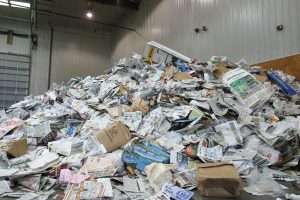It is time. The dreaded finals week. James B. Duke Furman Library is crowded with overwhelmed and sleep deprived students. The atmosphere is thick with tension and anxiety. I, myself, sit amongst the crowd buried deep within my semester’s notes and my textbooks. As my focus drifts, I look around at my surroundings and notice there are a lot of notes and textbooks laid out around me. That is a lot of paper. I begin to question, with all this paper- how is this good for the environment? Are there any better alternatives to traditional hard-covered textbooks and spiral notebooks for students? Would these alternatives be viable and actually sustainable? 
Since kindergarten, I have been taught that paper is bad for the environment, it destroys the rainforests and natural habitats, and I should always recycle my paper waste. So how bad is paper production for the environment? According to the online Paper Calculator presented by the Environmental Paper Network, manufacturing one pound of standard copy paper would result in the release of 9.0 pounds of carbon dioxide, the use of 10.7 gallons of water, the use of 0.02 US short tons of wood, creation of 0.6 pounds of solid waste, and the total energy required would equate to 0.01 million BTUs. So these numbers appear daunting, but what do they actually mean? Luckily, the Paper Calculator provides further explanation of these measured values. The production of one pound of paper releases the same amount of carbon dioxide as 0.001 cars per year. The 10.7 gallons of water used to make one pound of paper corresponds to 0.008 clothes washing machines operating per year. One pound of paper is made from approximately 0.01 trees. 0.6 pounds of solid waste is generated by 0.1 people daily. And finally, 0.02 residential refrigerators operated per year generates the equivalent 0.01 million BTUs of energy needed to produce one pound of standard copy paper. (1) These numbers may not seem so bad for one pound of paper. However, according to the Environmental Protection Agency, ”the average American uses more than 700 pounds of paper a year.” (2) Now multiply the numbers above by the 700 pounds and by over 330 million Americans, and you can see that paper production has substantial implications on the environment.

So what alternatives to paper are there? Probably the most popular suggested solution is the substitution of paper with technology such as laptops, tablets, and eBooks. Especially with advancements with technology that allow users to take as many notes and download as many files as their harddrive can contain. It appears as a simple and an easy solution to decrease paper waste, however is this solution so simple? Learning about sustainability, I learned that one of the key pillars is social equity. Tablets, laptops, and note-taking applications all cost a lot of money. An iPad 10 sold on the Apple website cost $449 while a 70 page spiral notebook costs 34 cents at Office Depot. Individuals from various socioeconomic backgrounds may not have the luxury to renounce themselves from using paper, and forcing the digitalization of academia may further encourage economic and social disparities. Additionally, when writing this blog post, I consulted with the Queen of Notetaking, my older sister. She has been avidly taking paper notes and purchasing physical copies of books throughout her entire education. When I asked her what she thought about switching to electronic notes, she told me it would be impossible given she is a spatial learner, and she is able to memorize content based on its location within a book or within her notebooks. So switching to electronic note taking could potentially put individuals, like my older sister, with spatial memory at a disadvantage. Finally, when researching the topic, I came across a study, published in August of 2020, which compared the Environmental Life Cycle Assessments (an evaluation of the product upon the environment over its lifespan) between a notebook, an Apple iPad tablet, and a reMarkable tablet. The study was able to conclude that “the paper notebook [outperformed] the tablets in almost all impact categories… a student considering a new note-taking device, paper notebooks seem to be more environmentally friendly than the tablets, given the current state of technology.” (3)
It seems that reducing the environmental impact of paper production is a difficult problem to tackle with no simple solution. Afterall paper has been a part of humankind since 105 AD and has been instrumental in documenting history, preserving cultures, and facilitating communication. I do not believe we will ever be without paper. However, with advancements of technology and education about sustainability, I believe we can come up with some compromises. Raising awareness and encouraging individuals to be more conscious of their paper use and waste is a good start. Encouraging recycling and the use of paper made from recycled materials can also be beneficial. Also, possibly implementing a note or textbook exchange, where students share their paper notes and textbooks once they complete their finals. I think implementing these small changes can be a great start to decrease the environmental effects of paper manufacturing until more technological advancements and sustainable solutions can become available.